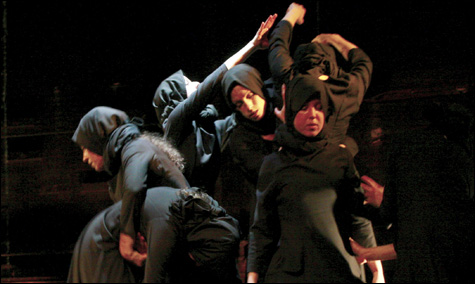
DEVIL’S WEDDING: Women under Islamic fundamentalism? Or war widows anywhere? |
All three dances on Prometheus Dance’s Memorial Day–weekend program at Boston Conservatory Theater seemed to tell of women’s travails and their temporary deliverance. Choreographed by Diane Arvanites-Noya and Tommy Neblett over three years, Dievas Mannu/Full Moon (2006), Knowing We Can Never Know (2003), and Devil’s Wedding (2006) were presented under the collective title “Devil’s Wedding.” All 10 dancers were women. From dance to dance, they shared a movement vocabulary that suggested pain, struggle, solace, and submission to unseen but unbreakable constraints.
Full Moon might take place in any ancient culture — India, Turkey, aboriginal North America. Six dancers in white peasant-like tunics with flared skirts and bells on one ankle enter in a slow procession. Snow is falling in a spotlit corner of the stage. A foggy forest is projected on the backdrop.
Archaic voices and wolf cries accompany their ceremonies. (The music is performed by Finnish singer Wimme Saari.) At some point, one woman becomes separated from the others. Someone crouches over her and seems to cast a spell. The group enter in a tight cluster waving white branches in unison, perhaps warding off danger, perhaps celebrating nature. The forest turns green, briefly, then gets fogged in again, and after a group circle dance, the women revolve in a tight cluster under a rising moon.
In Knowing We Can Never Know, eight women pace back and forth, wearing identical dresses in a silky but drab gun-metal fabric. The music is Shostakovich’s String Quartet No. 8. The women enact a series of strange patterned actions; no pattern can be finished until all of them have reinscribed it. A woman walks down a diagonal. At the end of the path, she sinks to the floor and starts rolling back the way she came. The next woman in line steps over her, gets to the end, sinks to the floor, rolls back.
They lift one another awkwardly, each woman carrying her partner a short distance and setting her down gingerly, like a basket of china. They roll across the proscenium with their heads out over the edge of the stage. Four tall ladderback chairs stand behind them, with short ladders suspended in mid air over each one. The women take turns sitting in the chairs, climbing on them, sliding off them. As the piece ends, one woman is standing on a chair looking up, but she doesn’t reach for the ascending ladder.
Devil’s Wedding begins with loud explosions and gunfire. The seven women wear long black shifts, and they seem to be confined in a bunker or a refugee compound. The stage is set sparsely but evocatively, as in the other two dances, with the back wall exposed, and odd pieces of lumber and ropes suggesting a barricade. There’s a ladder rising out of sight and, next to what might be an entrance, a low pile of sacks that might contain rice — or sand.
The women run in desperate circles. One or another of them starts up the ladder; the others pull her down. They huddle together. Intermittently there’s fast North African drumming and singing. (The music is by the Armenian duo Serart and the French trio Rajna.) The women dance to it, seem to become possessed by it. They envelop themselves in voluminous black veils. But when the dance ends, they’re still cooped up inside. One woman is starting up the ladder, but there’s not much chance she’ll escape.
The choreographers say the piece was inspired by the status of women under Islamic fundamentalism, but it could have been depicting war widows anywhere. I may not see the specific images Arvanites-Noya and Neblett worked with, but their dance has a theatrical power that insists on being taken seriously. For Devil’s Wedding, they designed the costumes and the set as well as the choreography. Linda O’Brien did the beautiful lighting for all three dances.